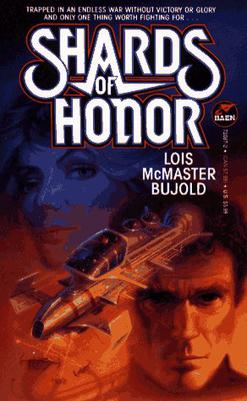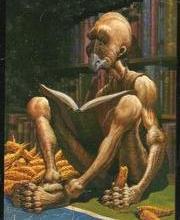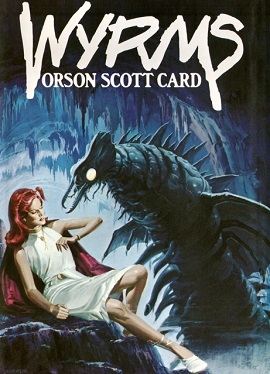Plot
The Skinner tells the story of three individuals who have journeyed to the 'line-world' (a world on the 'line', or border, of the Human Polity) of Spatterjay, a hostile mostly aquatic world with ferocious native lifeforms.
The planet Spatterjay is host to a complex virus that permeates throughout all life forms (including humans), propagated by a kind of leech which uses the virus to keep its prey alive whilst it feeds upon them. The virus optimizes life forms it infects for survival changing them, often rapidly, in response to environmental pressures. Humans need to consume food that is untainted by the virus (known colloquially as "dome grown") if they are not to be changed by the virus into something quite different. The Skinner is one such human who has "gone native", undergoing an horrific transformation.
Characters
The primary characters are:
Erlin Tazer Three Indomial, a 240-year-old doctor and xenobiologist who has come to Spatterjay hoping to find her old lover Captain Ambel and seeking a new meaning in her increasingly boring life
Janer Cord Anders, an 'eternal tourist' paid by a hornet hive-mind to travel the universe and carry hornet observers to new planets.
Sable Keech a thousand-year-old reification (a dead body reanimated by cybernetics) seeking the last of the eight people he swore to bring to justice for crimes against humanity during the Prador war.
Captain Ambel, one of Spatterjay's Old Captains, whose story, whilst unclear at first, is closely intertwined with the Skinner.
Spatterjay ″Jay″ Hoop, the eponymous "Skinner". One of the earliest residents and founder of Spatterjay, the Skinner has been cut off from supplies of dome grown human food and has been turned by the Spatterjay virus into a hybrid monster. When he was human, Jay lead a ruthless and sadistic gang of pirates named ″The Eight″. Their primary goal was trade with the alien Prador in human slaves, via removal of higher brain functions and spinal columns and implanting Prador thrilling devices into their central nervous system.

The Vorkosigan Saga is a series of science fiction novels and short stories set in a common fictional universe by American author Lois McMaster Bujold. The first of these was published in 1986 and the most recent in May 2018. Works in the series have received numerous awards and nominations, including five Hugo award wins including one for Best Series.

Apocalyptic and post-apocalyptic fiction is a subgenre of speculative fiction in which the Earth's civilization is collapsing or has collapsed. The apocalypse event may be climatic, such as runaway climate change; astronomical, such as an impact event; destructive, such as nuclear holocaust or resource depletion; medical, such as a pandemic, whether natural or human-caused; end time, such as the Last Judgment, Second Coming or Ragnarök; or more imaginative, such as a zombie apocalypse, cybernetic revolt, technological singularity, dysgenics or alien invasion.

Xenocide (1991) is a science fiction novel by American writer Orson Scott Card, the third book in the Ender's Game series. It was nominated for both the Hugo and Locus Awards for Best Novel in 1992. The title is a combination of 'xeno-', meaning alien, and '-cide', referring to the act of killing, together meaning the act of killing populations of aliens; comparable to genocide.

Planet of Exile is a 1966 science fiction novel by American writer Ursula K. Le Guin, part of her Hainish Cycle. It was first published as an Ace Double following the tête-bêche format, bundled with Mankind Under the Leash by Thomas M. Disch. In 2017, the rights for a movie were acquired by Los Angeles Media Fund.
Andrew "Ender" Wiggin is a fictional character from Orson Scott Card's 1985 science fiction novel Ender's Game and its sequels, as well as in the first part of the spin-off series, Ender's Shadow. The book series itself is an expansion, with some changes to detail, of Card's 1977 short story "Ender's Game."
The concept of Self-replicating spacecraft, as envisioned by mathematician John von Neumann, has been described by futurists including physicist Michio Kaku and discussed across a wide breadth of hard science fiction novels and stories. Self-replicating probes are sometimes referred to as von Neumann probes. Self-replicating spacecraft would in some ways either mimic or echo the features of living organisms or viruses.

Pak Breeders and Pak Protectors are two developmental stages of fictional life in Larry Niven's Known Space universe. The Pak first appeared in "The Adults", which appeared in Galaxy in 1967; this story was expanded into the novel Protector by Larry Niven (1973). The Pak also appear in several of Niven's later novels, notably those set in the Ringworld.
Captain Future is a pulp science fiction hero — a space-traveling scientist and adventurer —originally published in his namesake pulp magazine from 1940 to 1944. The character was created by editors Mort Weisinger and Leo Margulies. The majority of the stories were authored by Edmond Hamilton. A number of adaptations and derivative works followed. Significant was a 1978-79 Japanese anime (キャプテン・フューチャー), which was dubbed into several languages and proved popular, particularly in Spanish, French, German, Italian and Arabic. His francophone name is Capitaine Futur, although he is better known in francophone countries under the name Capitaine Flam.

Protector is a 1973 science fiction novel by American writer Larry Niven, set in his Known Space universe. It was nominated for the Hugo in 1974, and placed fourth in the annual Locus poll for that year.

The Slitheen are a fictional family of massive, bipedal extraterrestrials from the British science fiction television series Doctor Who and are adversaries of the Ninth Doctor and later Sarah Jane Smith. The Slitheen are of the egg-laying calcium-based Raxacoricofallapatorian race native to Raxacoricofallapatorius, though many use "Slitheen" in referring to the race in general. Instinctive hunters trained to kill at a young age, Slitheen are a ruthless criminal sect whose main motivation is profit. They are also convicted on their home world, not willing to return to their planet due to a death sentence.

Eric John Stark is a character created by the science fiction author Leigh Brackett. Stark is the hero of a series of pulp adventures set in a time when the Solar System has been colonized. His origin-story shares some characteristics with feral characters such as Mowgli and Tarzan; his adventures take place in the shared space opera planets of 1940s and 1950s science fiction.
The Wess'har Wars series is a six-book science fiction novel series written by author Karen Traviss and is set several hundred years in the future. It involves humanity's contact with a number of alien species with conflicting interests and beliefs, while her central character, Shan Frankland, is caught in the middle of a coming conflict. All six novels have been published by Eos, an imprint of HarperCollins: City of Pearl, Crossing the Line, The World Before, Matriarch and Ally. The last book of the series, Judge was released on March 25, 2008.
The Helliconia trilogy is a series of science fiction books by British writer Brian W. Aldiss, set on the Earth-like planet Helliconia. It is an epic chronicling the rise and fall of a civilisation over more than a thousand years as the planet progresses through its incredibly long seasons, which last for centuries.

The Martians, also known as the Invaders, are the fictional race of extraterrestrials from the H.G. Wells 1898 novel The War of the Worlds. They are the main antagonists of the novel, and their efforts to exterminate the populace of the Earth and claim the planet for themselves drive the plot and present challenges for the novel's human characters. They are notable for their use of extraterrestrial weaponry far in advance of that of mankind at the time of the invasion.
The planetary systems of stars other than the Sun and the Solar System are a staple element in many works of the science fiction genre.
This is a list of terminology used in the fictional Dune universe created by Frank Herbert, the primary source being "Terminology of the Imperium", the glossary contained in the novel Dune (1965).

Courtship Rite is a science fiction novel by Canadian writer Donald Kingsbury, originally serialized in Analog magazine in 1982. The book is set in the same universe as some of Kingsbury's other stories, such as "Shipwright" (1978) and the unpublished The Finger Pointing Solward.

Wyrms (1987) is a science fiction novel by American writer Orson Scott Card. The story examines desire, wisdom, and human will. Card describes a version of the tri-partite soul, similar to that articulated by Plato in The Republic.











